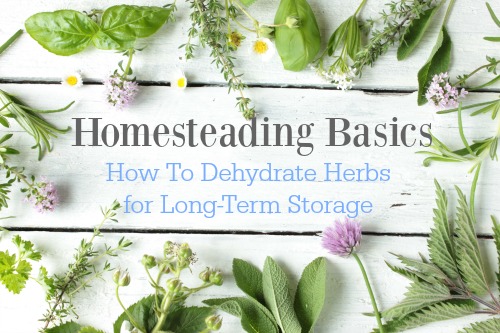Herbs are one of the first plants we put in our garden. There is nothing like fresh culinary herbs to intensify the flavors of food. As well, herbs are hardy garden plants that don’t have to be watered as much as vegetables and can serve more than one purpose by being used as natural medicine.

For instance, did you know that a sage leaf can be used instead of a band-aid because it has natural healing qualities? Some of these popular culinary herbs are oregano, thyme and sage and can grow year-round in many parts of the country.
To enjoy these herbs year round, many choose to dehydrate them when they are at the peak in freshness and combine them to make their own spices and even homemade tea blends. Can you imagine how much money you could save at the grocery store by implementing this into your pantry?
Homesteading Basics : How To Dehydrate Herbs for Long-Term Storage
Dehydrating herbs and other leafy greens is one of the easiest items to dry for long-term use. All you really need is a constant stream of air. You don’t necessary have to own a food dehydrator because herbs can dry naturally from the air, but it does help with even drying.
Here are some steps to get started:
- Prep herbs for drying. Wash and place herbs evenly on a drying rack and ensure that enough space is made for proper air flow.
- Set temperature and time according to the directions on your dehydrator.
- Ensure that herbs are 95% dehydrated for long-term storage.
Here are some great spice mixes to start adding to your pantry!
Cajun Seasoning
- 1/3 cup salt
- 1/4 cup paprika
- 1 tablespoon onion powder

- 1 tablespoon garlic powder
- 1 tablespoon ground black pepper
- 1 tablespoon basil
- 1 tablespoon dried oregano
- 1 tablespoon ground coriander
- 1/2 teaspoon cayenne pepper
- 2 teaspoons dried thyme
- 1/4 teaspoon cumin
- 1/4 teaspoon white pepper
Chili Powder
- 2 tablespoons paprika
- 2 teaspoons dried oregano
- 1 1/2 teaspoon ground cumin
- 1 1/4 teaspoon garlic powder
- 1 1/4 teaspoon cayenne pepper
- 1 teaspoon onion powder
French Herb Mix
- 3 tablespoons marjoram
- 3 tablespoons dried thyme
- 3 tablespoons savory
- 2 tablespoons garlic powder
- 1 teaspoon dried basil
- 1 teaspoon dried rosemary
- 1 teaspoon sage
- 1/2 teaspoon ground fennel seed
Chili Powder
- 2 tablespoons paprika
- 2 teaspoons dried oregano
- 1 1/2 teaspoons garlic powder
- 1 1/4 teaspoons ground cumin
- 1 1/4 teaspoon cayenne pepper
- 1 teaspoon onion powder
Storing Dehydrated Herbs
Herbs can be dehydrated to store for longer periods, but storage is important for any preserved food, and dehydrated foods are no exception. Store either in heavy-duty zippered bags in a metal container, or store in dry, sterile, glass jars. For long-term storage, I recommend using Mylar bags.
As I stated previously, before storing, you want to ensure that your food is 95% or more dehydrated because the more moisture your food has the more likely molds and microorganisms can grow. Like all emergency food sources, ensure that you keep your dehydrated food away from natural elements.
“Best Used By” Guidelines for Dehydrated Food
- Spices – 1-2 years
- Vegetables/Fruits – Up to 12 months
- Meats – Best at 1-2 months, but can be stored for 6 months.
We are all looking for frugal ways to bulk up our preparedness pantries. Using herbs is a great way to do that. Some of our favorite herbs we love to grow in our garden can be utilized to make long-term herbal seasonings to use year round. So, what are you waiting for? It’s time to start dehydrating!
This information has been made available by Ready Nutrition
CHECK OUR survival and prepping solutionsIf you found this article useful, please like our Facebook page and stay up to date with the latest articles.
WHAT TO READ NEXT:
HOW TO MAKE YOUR OWN BACON (STEP BY STEP GUIDE)
A RETURN TO THE OLD PATHS: HOW TO MAKE PEMMICAN LIKE THE NATIVE AMERICANS
20 LOST RECIPES FROM THE PIONEERS: WHAT THEY COOKED ON THEIR JOURNEY WESTWARD
SEVEN CLASSIC GREAT DEPRESSION ERA RECIPES GRANDMA USED TO MAKE
POTTED MEAT: A LOST SKILL OF LONG TERM MEAT STORAGE
BACK TO BASICS: HOW TO MAKE AND PRESERVE LARD
THE BEST WAY TO STOCKPILE VEGETABLES OFF-GRID
OLD FASHIONED PRESERVING-GRANDPA’S RECIPE FOR CURED SMOKED HAM
HOW TO MAKE GUNPOWDER THE OLD FASHIONED WAY
SURVIVAL HERBAL RECIPES FROM OUR ANCESTORS
HOW TO PRESERVE MEAT FOR SURVIVAL LIKE OUR GRANDFATHERS
OTHER USEFUL RESOURCES:
The 3 Pioneer Survival Lessons We Should Learn
The Most Effective Home Defense Strategies
Old School Hacks for Off-Grid Living
The Medical Emergency Crash Course
Tess Pennington is the author of The Prepper’s Blueprint, a comprehensive guide that uses real-life scenarios to help you prepare for any disaster. Because a crisis rarely stops with a triggering event the aftermath can spiral, having the capacity to cripple our normal ways of life. The well-rounded, multi-layered approach outlined in the Blueprint helps you make sense of a wide array of preparedness concepts through easily digestible action items and supply lists.
Tess is also the author of the highly rated Prepper’s Cookbook, which helps you to create a plan for stocking, organizing and maintaining a proper emergency food supply and includes over 300 recipes for nutritious, delicious, life-saving meals.
Visit her web site at ReadyNutrition.com for an extensive compilation of free information on preparedness, homesteading, and healthy living.


One Reply to “How To Dehydrate Herbs for Long-Term Storage”